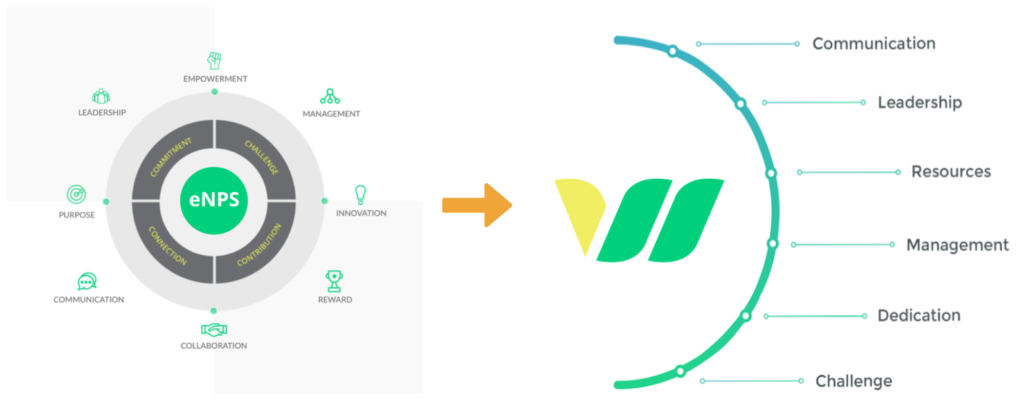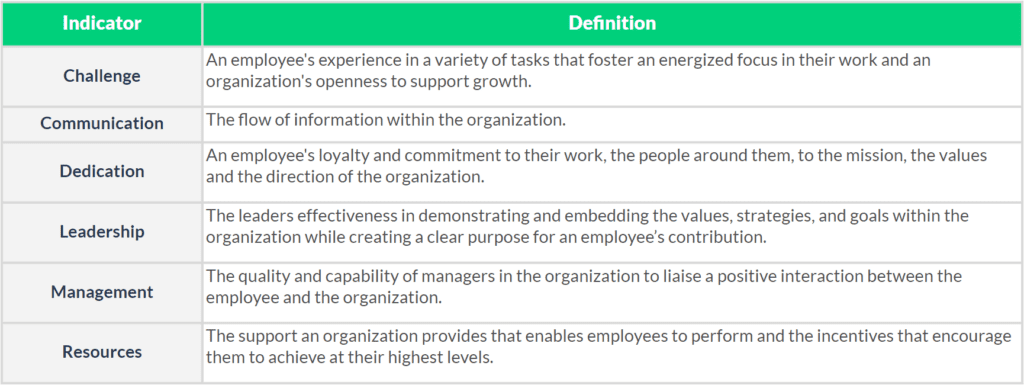June 25, 2019


In an effort to continuously enhance the service Workify provides, we have been hard at work improving upon the Workify Culture Model. Today, we are excited to announce updates to our model that will improve the data and analysis we provide you and your company. In this post we will walk you through, in detail, the changes that we have made and how they will benefit your organization.
The goal of evolving the current model is to provide a more precise representation of engagement within your organization. Having a more statistically reliable instrument will allow Workify to produce more targeted insights that will support meaningful change that can increase the level of engagement at work.
Continue reading below to learn more about our improved methodology for measuring employee engagement and driving action.
Organizational Engagement Dilemma
Our initial approach to measuring engagement provided a fresh perspective on a traditional space, but as we’ve worked with hundreds of organizations we’ve noticed two emerging trends that are causing friction in the effort to drive better results: Balancing flexibility with simplicity & Reducing time from insight to action.


Based on client experience and feedback, we approached our I/O Psychology advisory board to review our definition of engagement, the functionality of the culture model, the accuracy of engagement indicators and our question library. We then worked to make changes to our model that would improve the precision of results while maintaining flexibility in the approach. The outcome of the review, as represented by Culture Model 2.0, will increase the speed in generating insights and will more clearly identify your next steps and areas to take action.
Enhanced Definition of Engagement
Simplifying our definition of employee engagement was the first step in developing a model that would begin to reconcile the challenges that companies are facing in improving employee engagement in their companies.


Our refined definition of engagement provides the foundation for an enhanced methodology and the pillars for how we will measure employee engagement.
A More Simplified Approach
While engagement is an employee experience, indicator measurements should provide direction for action by the organization, and we’ve determined that a simplified model with more firmly defined indicators will offer increased statistical accuracy and directional focus.
We’ve mapped our original twelve indicators into 6 more clearly defined indicators:


Our I/O Psychology team analyzed our historical data to determine which indicators trended across the bulk of our baseline surveys. Once they narrowed these indicators, they applied the latest theory and research to determine how we could consolidate the remaining items into new constructs. The result is a simplified set of indicators that’s grounded in I/O research and more strongly tied to our definition of employee engagement.
Simplicity with Precision
Our 12 original indicators have now been rolled up into 6 indicators that best represent our understanding of Employee Engagement. This new model provides a simpler and more accurate method of measuring an employee’s experience of engagement at work.


Having determined a more focused set of indicators, we can provide more confidence in the directional results and insights garnered from your engagement data. In order to harness these insights, the baseline survey approach needed to evolve.
Introducing the New Workify Baseline Survey
We’ve discussed how we refined our definition of engagement and reworked our indicator model, so now it’s time to get to the survey itself.
The new and improved baseline was designed with a singular focus on measuring drivers of engagement as defined by the 6 new indicators. The survey has been extended to a total of 34 questions: 1 eNPS, 1 Retention question, 30 likert questions pertaining to indicators (5 questions per indicator) and 2 qualitative questions. All of the questions in the new baseline were sourced from Workify’s expanded library and many will look familiar from our historic baseline.
So, why have we extended the length of our survey? According to research methodology, asking more questions per indicator will provide more accurate results and stronger insights to the indicators of the survey.
This has led to the use of 5 questions per indicator. With our new baseline, the survey length will be short enough to promote high participation, but long enough to provide more statistically relevant direction. Another adjustment that we’ve made is the introduction of negatively worded likert questions, within each indicator we have added one negatively worded question. Including negatively worded or reverse worded questions in the baseline will serve as a tool for increasing the reliability of the responses.
These help to function as an attention check on those who are taking the survey to ensure they are reading the questions and responding appropriately. Once again these updates to our baseline are geared toward improving upon the quality of results being delivered to your organization. As your engagement partner, we feel that it is critical to help organizations continuously improve the accuracy of the data and decisions they are making.
Now that we have summarized the changes to our approach, it is time to unveil the survey itself, please click the button below to view the new Workify Baseline Survey in its entirety.

